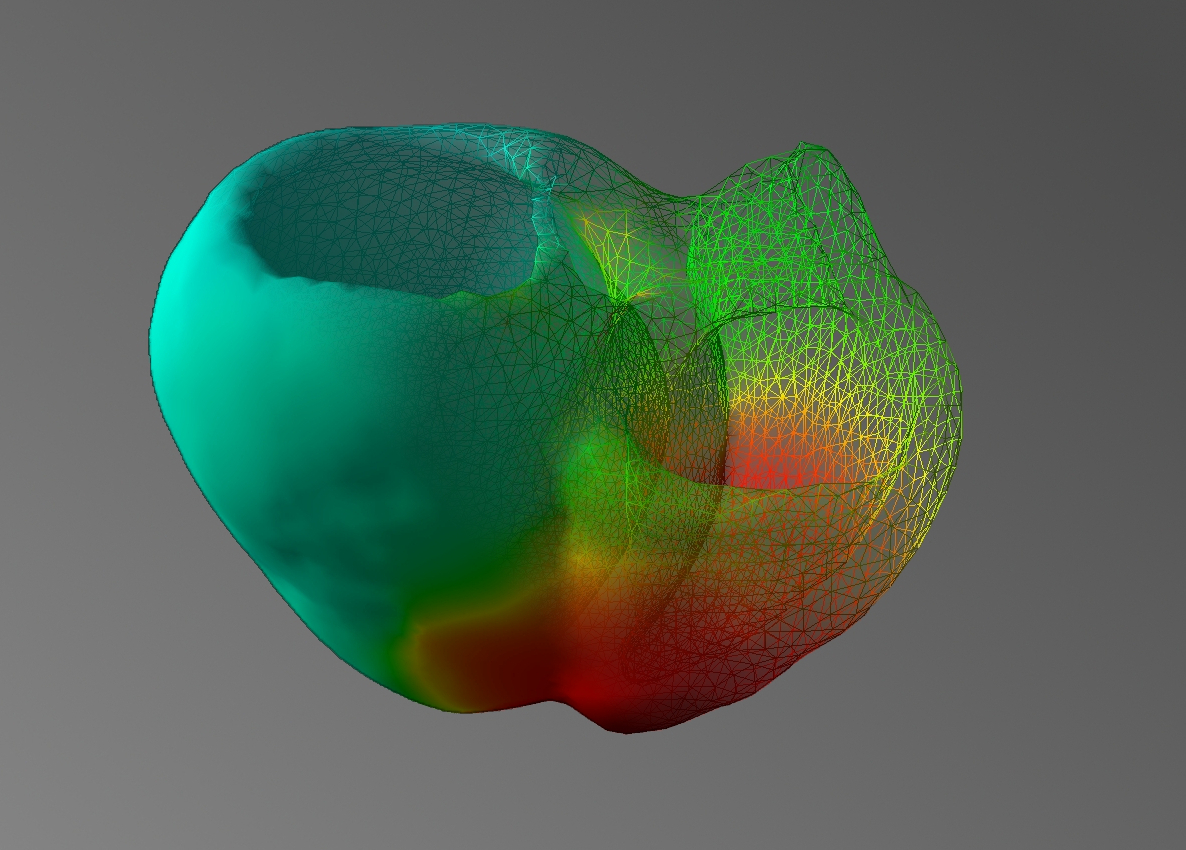Section: Research Program
Real-Time Biophysical Models
The principal objective of this scientific challenge is the modeling of the operative field, i.e. the anatomy and physiology of the patient that will be directly or indirectly targeted by a medical intervention. This requires to describe various phenomena such as soft-tissue deformation, fluid dynamics, electrical diffusion, or heat transfer. These models will help simulate the reaction of the patient’s anatomy to the procedure, but also represent the behavior of complex organs such as the brain, the liver or the heart. A common requirement across these developments is the need for fast, possibly real-time, computation.
Real-time biomechanical modeling of solid structures
Soft tissue modeling holds a very important place in medical simulation. A large part of the realism of a simulation, in particular for surgery or laparoscopy simulation, relies upon the ability to describe soft tissue response during the simulated intervention. Several approaches have been proposed over the past ten years to model soft-tissue deformation in real-time (mainly for solid organs), usually based on elasticity theory and a finite element approach to solve the equations. We were among the first to propose an approach [3] using different computational strategies. Although significant improvements were obtained later on (for instance with the use of co-rotational methods to handle geometrical non-linearities) these works remain of limited clinical use as they essentially rely on linearized constitutive laws, and are rarely validated. An important part of our research remains dedicated to the development of new, more accurate models that are compatible with real-time computation. Such advanced models will not only permit to increase the realism of future training systems, but they will act as a bridge toward the development of patient-specific preoperative planning as well as augmented reality tools for the operating room.
Real-time biomechanical modeling of hollow structures
A large number of anatomical structures in the human body are vascularized (brain, liver, heart, kidneys, etc.) and recent interventions (such as interventional radiology procedures) rely on the vascular network as a therapeutical pathway. It is therefore essential to model the shape and deformable behavior of blood vessels. This can be done at two levels, depending of the objective. The global deformation of a vascular network can be represented using the vascular skeleton as a deformable (tree) structure, while local deformations need to be described using models of deformable surfaces. Other structures such as aneurysms, the colon or stomach can also benefit from being modeled as deformable surface, and we can rely on shell or thin plate theory to reach this objective.
Coupled physical models
Beyond biomechanical modeling of soft tissues, other physical phenomena have to be taken into account. In the context of percutaneous tumor ablation, both thermal and mechanical behaviors have to be modelled. Focusing especially on the simulation of cryoablation (freezing the pathological tissue), models for heat transfer have been implemented to simulate the evolution of temperature within living tissues. Pre-operative planning of the iceball can thus be envisaged. Moreover, this demonstrates the multi-physics aspect of SOFA.
Real-time electrophysiology
Electrophysiology plays an important role in the physiology of the human body, for instance by inducing muscles motion, and obviously through the nervous system. Also, many clinical procedures rely on electrical stimulation, such as defibrillation, neuromuscular or deep brain stimulation for instance. Yet, the modeling and the simulation of this phenomenon is still in its early stages. Our primary objective is to focus on cardiac electrophysiology, which plays a critical role in the understanding of heart mechanisms, and also in the planning of certain cardiac procedures. We propose to develop models and computational strategies aimed at real-time simulation, and to also provide personalization tools (parameter estimation) allowing to run patient-specific simulations from clinical data.


